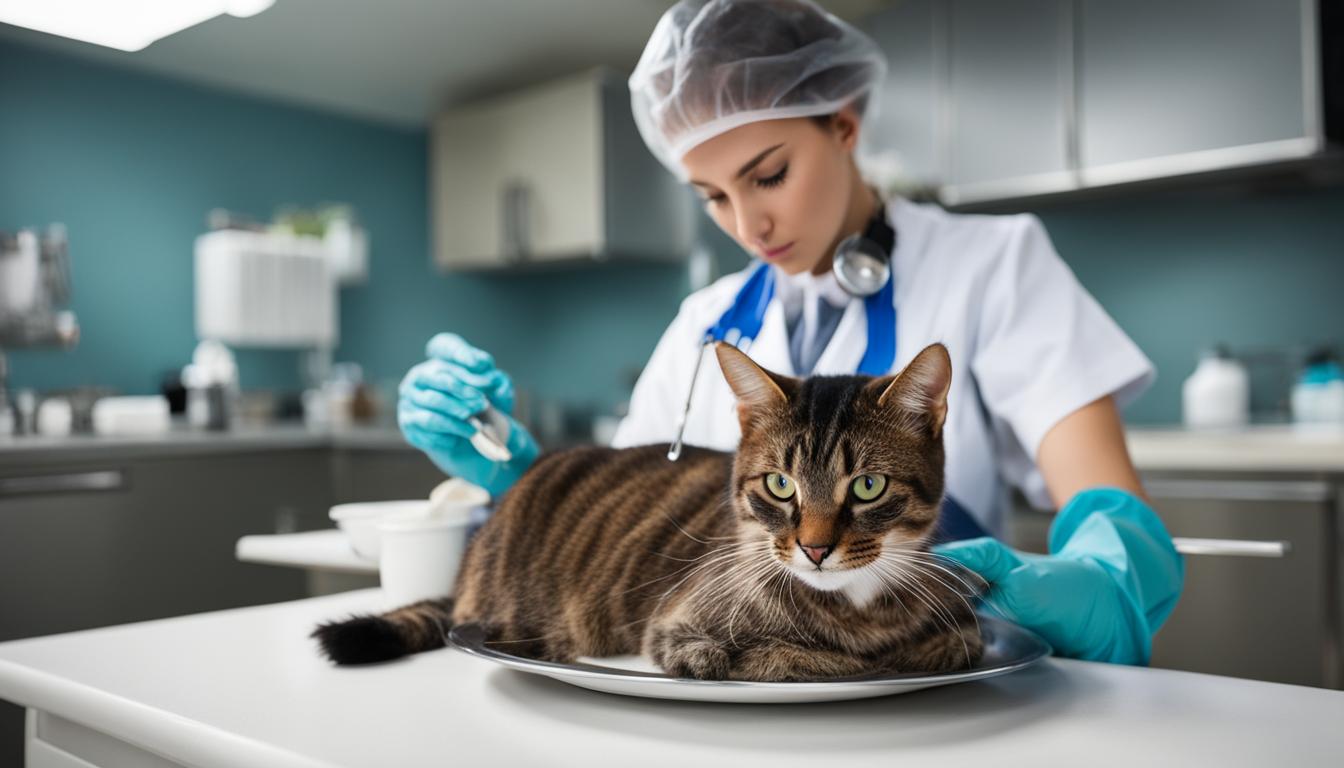Your cat is part of your family, and just like any family member, you want to keep them safe and healthy. Understanding the risks your furry friend may face is an important part of caring for them. One such risk is the rabies virus, a serious concern regarding feline health.
Rabies in cats is a disease that can affect their brain and is always serious. But don’t worry, there’s a way to stop this virus! A rabies vaccine for cats can protect your pet. This vaccine stops your cat from getting rabies. Like all vaccines, it teaches your cat’s body how to fight off the virus before it can make them sick.
It is rare for a cat to get rabies, but it can happen. If a cat with rabies bites your cat, or if their saliva gets into a cut or scratch, your cat could get the virus. The signs that a cat has rabies can be scary. They might become mean, want to hide all the time, or act very strange. But if it gets caught early, before these rabies symptoms show up, a vet can help.
To keep your cat safe from the rabies virus, it’s important to get them their shots and to keep them away from wild animals. This is the best rabies prevention. If you take good care of your cat in these ways, it’s unlikely they will ever get rabies.
Key Takeaways
- Rabies is a virus that can affect your cat’s brain and health.
- There is a special shot called a vaccine that can protect cats from rabies.
- Cats get rabies from other animals that have it, mostly through bites.
- The signs of rabies in cats can include them acting mean or strange.
- Taking your cat to the vet for their rabies shots can stop them from getting sick.
- Keeping cats away from wild animals is a good way to prevent rabies.
Understanding Rabies and Its Impact on Cats!
Have you ever heard about rabies? It’s a disease that can make animals very sick and it can be serious if not taken care of. Cats can get rabies too, and it’s important to know how it affects them.
What is Rabies?
Rabies is caused by a virus that attacks the nerves in the body. When this virus gets inside, it can spread to the brain and cause big problems. Animals with rabies may act strange or even become angry for no reason.
How Common is Rabies in Cats?
In the United States, more cats get sick with rabies than dogs. It’s not very common, but when it does happen, it’s usually because they were bitten by another animal that has rabies. This is why keeping an eye on our furry friends is super important!
Recognizing the History of Rabies
Did you know that people have known about rabies for a very long time, like since 2300 BC? That’s more than 4,000 years ago! Even though it’s old, doctors and scientists today know a lot more about how to keep pets safe from rabies.
Rabies Transmission: How Do Cats Contract It?
Have you ever wondered how your furry friends might get rabies? Rabies transmission in cats usually happens from the bite of a sick animal. Those animals could be skunks, raccoons, foxes, and big bats, all of which may carry rabies. If a cat gets bitten, the bad virus from the sick animal’s saliva can get inside the cat’s body. This is why bite wound rabies risk is serious for kitties. Sadly, once the virus gets inside, it can make the cat sick with a cat rabies infection.
Let’s make sure you understand how the rabies spread works. Look at the below table and see which animals carry rabies. Remember, not all animals have rabies, but it’s good to know which ones might so you can keep your cats safe. Here’s a hint: those animals live mostly outside, and they like to wander during the night!
| Animal | Chance of Having Rabies |
|---|---|
| Skunks | High |
| Raccoons | High |
| Foxes | Medium to High |
| Bats | High |
If your cat ever gets bitten, you should take them to the vet right away. The vet knows how to help your cat to not get sick from the bite. It’s like when you get a scrape, and your mom or dad puts a band-aid on it to make it better. The vet will do something like a special “band-aid” for your cat!
So now you know, bites from certain animals can be a problem for cats. Always look after your kitty friends and keep them away from wild animals, so they don’t get rabies. It’s important to help our cats lead a happy and healthy life without the worry of cat rabies infection!
Can Cats Get Rabies: Identifying the Risks
Did you know that cute animals in the wild, like skunks and foxes, could be danger-spots for a disease called rabies? And even cats that don’t have a home, the ones we call strays, can be risky for your pet cat. Let’s chat about why it’s important to watch out for rabies and how you can help keep your cat safe. Remember, your fuzzy buddy depends on you to stay out of trouble!
The Role of Wildlife and Stray Animals
When we think of furry friends like raccoons and bats, we may not realize that they can carry something as scary as rabies. If your cat likes to explore outside, they might bump into these wild animals which is a big rabies risk factor. Remember to keep a lookout for wild creatures if you live where they’re often seen.
The Crucial Factors Affecting Rabies Transmission
Rabies can also come from stray cats and that’s a real stray cats rabies risk. These cats often fight, and a bite could pass on the virus. If your cat gets bitten, it’s super important to see the vet right away. Cats can show signs of rabies in three to eight weeks, which is really fast!
Real Stories of Feline Rabies
Stories told by people show that rabies is nothing to ignore. One family’s cat, which loved the outdoors, got into a fight with a wild critter and sadly got rabies. This shows it’s super-important to prevent rabies before it ever happens! Let’s make sure our cats get their shots and stay out of harm’s way. Here’s a table that shows common rabies feline rabies sources in wildlife:
| Wild Animal | Region | Known for Rabies |
|---|---|---|
| Skunks | North America | Yes |
| Raccoons | North America | Yes |
| Foxes | North America | Yes |
| Bats | Worldwide | Yes |
To wrap it up, while cats can be curious, we can help keep them healthy by being careful about wild animal rabies and watching out for stray cats. Give your cat love, good care, and make sure they get their rabies vaccine. Let’s work together to keep our purring pals safe and sound!
Recognizing Symptoms: The Stages of Rabies in Felines
Understanding rabies symptoms in cats is important for keeping your furry friends safe. Let’s talk about the different stages of feline rabies and what symptoms you might notice in each one.
Early Stage: Prodromal Symptoms
In the beginning, or prodromal stage, you might see your normally sleepy kitty become unusually jumpy or nervous. Other cats may get grumpy or lick their paws more than usual.
Mid Stage: Furious Phase of Rabies
As the disease moves to the furious rabies phase, your cat might act really wild. They could bark, bite, or dash around like they’re scared of something, even when nothing is there.
Final Stage: Paralysis and the End
Lastly, the paralytic rabies stage can cause weak muscles and trouble breathing. Sadly, this is the last part of the disease. It usually leads to sleepiness, coma, and then the cat may pass away within 2 to 4 days after these signs start.
Vaccinations and Prevention of Rabies in Cats
Hey there, loving cat owners! Let’s talk about keeping your furry friends safe from rabies. It’s a scary disease, but the good news is that there’s a shield that protects your cats: the rabies vaccine. When your little buddy gets this shot, it’s getting a superpower against rabies. This vaccine is so important it’s even a must-have by law in many places. It’s a big part of rabies prevention for your feline friend.
Starting from when your kitten is about 3-4 months old, it will get a feline vaccination series. These shots teach your cat’s body how to fight the rabies virus. Just like you get booster shots, cats need them too. The booster shots help make sure the protection lasts a long time.
Even though the vaccines are super strong, they’re not an invisible cloak. That means you still have to be careful and keep your kitties away from wild animals that might carry rabies. That keeps the risk really low. It’s all part of what doctors call rabies inoculation for cats. Keeping your cat safe is easy when you stay on top of these shots and follow the vet’s advice.
Remember: Vaccines are heroes in the fight against rabies, but your careful eye is just as important!
To show you how important this is, here’s a quick table you can check out:
| Age | Shot | Why It’s Important |
|---|---|---|
| 3-4 months | First rabies vaccine | Gets your kitten started on rabies protection |
| 1 year later | Booster shot | Keeps your cat’s rabies shield strong |
| Every 1-3 years | Further boosters | Ensures long-term defense against rabies |
By keeping up with your cat’s vaccination schedule, you’re doing the best thing to prevent rabies. Give yourself a pat on the back for being such a great cat protector!
Conclusion
As a caring cat owner, it’s super important to know about keeping your furry friend safe from rabies. Remember, once a cat shows signs of rabies, there’s no way to fix it. That’s why stopping it before it starts is the best way to go. You’ve got a big role to play in your cat’s health and happiness!
The Importance of Responsible Pet Ownership
Being a responsible cat owner means making sure your cat gets their shots to protect against rabies. It also means not letting them roam where they could meet wild animals with rabies. Keeping your cat safe helps them live a long and happy life with you. That’s part of loving and caring for your pet.
Understanding the Limits of Rabies Treatments
If your cat does get rabies, remember that there aren’t any treatments that can cure it. This fact shows just how important those shots and vet check-ups are. They are your best tools to prevent rabies from ever being a problem. Keep up with their healthcare, and they’ll thank you with lots of purrs and cuddles!
Emphasizing the Need for Regular Vet Visits
Your cat needs to visit the vet regularly, just like you have check-ups at your doctor. During these visits, your cat gets their rabies vaccine and the vet makes sure they’re healthy. Going to the vet keeps your cat’s health in top shape and protects both of you. Don’t forget, keeping your cat healthy means a healthier and happier home for everyone!
FAQ
Can cats get rabies?
Yes, cats can get rabies. Rabies is a virus that affects the nervous system of warm-blooded animals, including cats, and is usually fatal once symptoms appear.
What are the common symptoms of rabies in cats?
The symptoms of rabies in cats can include changes in behavior, such as a previously calm cat becoming agitated, aggression, muscle spasms, excessive drooling, difficulty swallowing, and pupils that may remain widely dilated. As the disease progresses, it can lead to paralysis, coma, and death.
How can my cat contract rabies?
Cats usually contract rabies through the bite of an infected animal. The saliva of an infected animal can carry the rabies virus, and when it is introduced beneath the cat’s skin through a bite wound, the virus can be transmitted.
Are rabies vaccines for cats effective?
Rabies vaccines for cats are considered very effective in preventing the disease. Kittens typically begin receiving a series of vaccines starting at 3-4 months, with booster shots recommended at intervals. Even though vaccinated cats can carry the virus in certain circumstances, vaccination is critical for prevention and is often mandated by law.
Can indoor cats benefit from a rabies vaccine?
Absolutely, even indoor cats should be vaccinated against rabies. While they may have a lower risk of exposure, they can still potentially come into contact with rabid animals, such as bats that enter homes.
How common is rabies in cats compared to other domestic animals?
Rabies is more commonly reported in cats than in dogs in the United States. Since 1990, there have been more annual reported cases of rabies in cats than in dogs.
What wildlife animals are common carriers of rabies?
In North America, common carriers of rabies include skunks, raccoons, foxes, and bats. Stray, free-roaming dogs in Asia, Africa, and Latin America also play a significant role in the transmission of rabies to cats.
How long can the rabies virus survive outside of a host?
The rabies virus does not survive long outside of a mammal’s body. It is a fragile virus that can only be transmitted through direct contact with the saliva of an infected animal, usually via bite wounds.
What is the history of rabies?
Rabies has a long history, with evidence of the disease dating back to 2300 BC. It has been recognized over centuries as a fatal disease if not prevented with vaccination.
How can I minimize the risk of my cat getting rabies?
Minimizing the risk involves regular rabies vaccinations, keeping your cat indoors or supervising outdoor activities closely, and avoiding contact with wild animals or unfamiliar pets. Responsible cat ownership and preventative measures are crucial.


